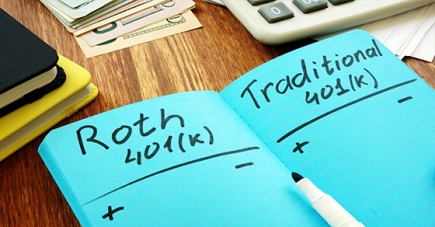Using your 401(k) plan to save this year and next
You can reduce taxes and save for retirement by contributing to a tax-advantaged retirement plan. If your employer offers a 401(k) or Roth 401(k) plan, contributing to it is a taxwise way to build a nest egg.
If you’re not already contributing the maximum allowed, consider increasing your contribution rate between now and year end. Because of tax-deferred compounding (tax-free in the case of Roth accounts), boosting contributions sooner rather than later can have a significant impact on the size of your nest egg at retirement.
With a 401(k), an employee elects to have a certain amount of pay deferred and contributed by an employer on his or her behalf to the plan. The contribution limit for 2019 is $19,000. Employees age 50 or older by year end are also permitted to make additional “catch-up” contributions of $6,000, for a total limit of $25,000 in 2019.
The IRS just announced that the 401(k) contribution limit for 2020 will increase to $19,500 (plus the $6,500 catch-up contribution).
A traditional 401(k)
A traditional 401(k) offers many benefits, including these:
- Contributions are pretax, reducing your modified adjusted gross income (MAGI), which can also help you reduce or avoid exposure to the 3.8% net investment income tax.
- Plan assets can grow tax-deferred — meaning you pay no income tax until you take distributions.
- Your employer may match some or all of your contributions pretax.
Take a look at your contributions for this year. If your current contribution rate will leave you short of the limit, try to increase your contribution rate through the end of the year to get as close to that limit as you can afford. Keep in mind that your paycheck will be reduced by less than the dollar amount of the contribution, because the contributions are pretax — so, income tax isn’t withheld.
Roth 401(k)
Employers may also include a Roth option in their 401(k) plans. If your employer offers this, you can designate some or all of your contributions as Roth contributions. While such contributions don’t reduce your current MAGI, qualified distributions will be tax-free.
Roth 401(k) contributions may be especially beneficial for higher-income earners, because they don’t have the option to contribute to a Roth IRA. Your ability to make a Roth IRA contribution in 2019 will be reduced if your adjusted gross income (AGI) in 2019 exceeds:
- $193,000 and your filing status in 2019 is married-filing jointly, or
- $122,000, and your filing status in 2019 is that of a single taxpayer.
Your ability to contribute to a Roth IRA in 2019 will be eliminated entirely if you’re a married-filing-jointly filer and your 2019 AGI equals or exceeds $203,000. The cutoff for single filers is $137,000 or more.
How much and which type
Do you have questions about how much to contribute or the best mix between regular and Roth 401(k) contributions? Contact us. We can discuss the tax and retirement-saving considerations in your situation.
© 2019
Still working after age 70½? You may not have to begin 401(k) withdrawals
If you participate in a qualified retirement plan, such as a 401(k), you must generally begin taking required withdrawals from the plan no later than April 1 of the year after which you turn age 70½. However, there’s an exception that applies to certain plan participants who are still working for the entire year in which they turn 70½.
The basics of RMDs
Required minimum distributions (RMDs) are the amounts you’re legally required to withdraw from your qualified retirement plans and traditional IRAs after reaching age 70½. Essentially, the tax law requires you to tap into your retirement assets — and begin paying taxes on them — whether you want to or not.
Under the tax code, RMDs must begin to be taken from qualified pension, profit sharing and stock bonus plans by a certain date. That date is April 1 of the year following the later of the calendar year in which an employee:
- Reaches age 70½, or
- Retires from employment with the employer maintaining the plan under the “still working” exception.
Once they begin, RMDs must generally continue each year. The tax penalty for withdrawing less than the RMD amount is 50% of the portion that should have been withdrawn but wasn’t.
However, there’s an important exception to the still-working exception. If owner-employees own at least 5% of the company, they must begin taking RMDs from their 401(k)s beginning at 70½, regardless of their work status.
The still-working rule doesn’t apply to distributions from IRAs (including SEPs or SIMPLE IRAs). RMDs from these accounts must begin no later than April 1 of the year following the calendar year such individuals turn age 70½, even if they’re not retired.
The law and regulations don’t state how many hours an employee needs to work in order to postpone 401(k) RMDs. There’s no requirement that he or she work 40 hours a week for the exception to apply. However, the employee must be doing legitimate work and receiving W-2 wages.
For a customized plan
The RMD rules for qualified retirement plans (and IRAs) are complex. With careful planning, you can minimize your taxes and preserve more assets for your heirs. If you’re still working after age 70½, it may be beneficial to delay taking RMDs but there could also be disadvantages. Contact us to customize the optimal plan based on your individual retirement and estate planning goals.

Walls & Associates is a certified public accounting firm serving the needs of businesses and individuals in the tri-state area of West Virginia, Kentucky, and Ohio. We are confident that regardless of size, we can fulfill your financial and tax accounting needs – whether it is a simple individual tax return, a consolidated multi-state corporate tax return, a nonprofit tax return, or general bookkeeping.
CONTACT US
-
Milton Office Location:
Phone: 304-390-5971
1025 N. Main Street
Milton, WV 25541 -
Hamlin Office Location:
Phone: 304-824-3880
19 3rd Street
Hamlin, WV 25523
WORKING HOURS
| Monday | 8:30 am - 5:00 pm |
| Tuesday | 8:30 am - 5:00 pm |
| Wednesday | 8:30 am - 5:00 pm |
| Thursday | 8:30 am - 5:00 pm |
| Friday | 8:30 am - 5:00 pm |
| Saturday | Closed |
| Sunday | Closed |

